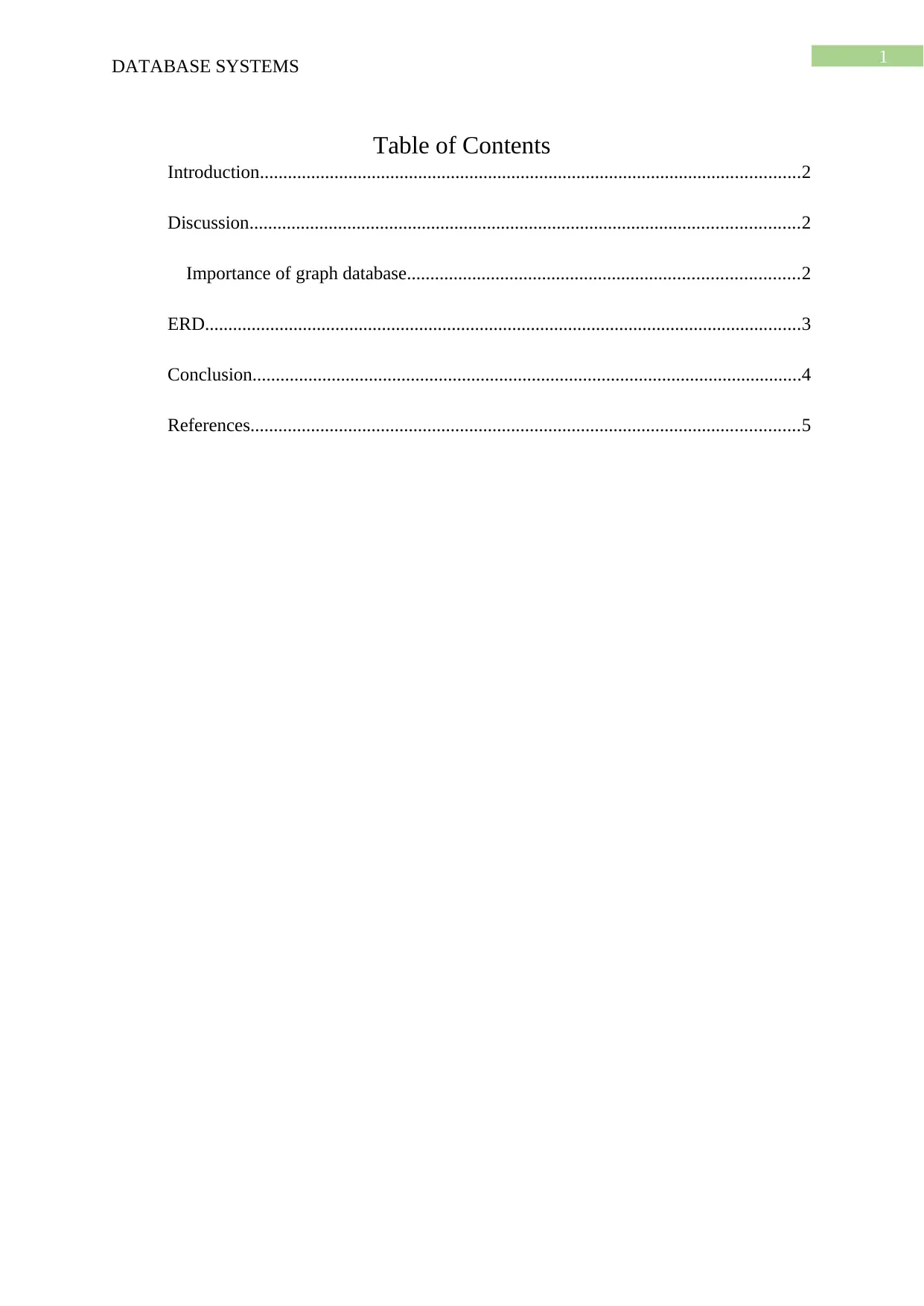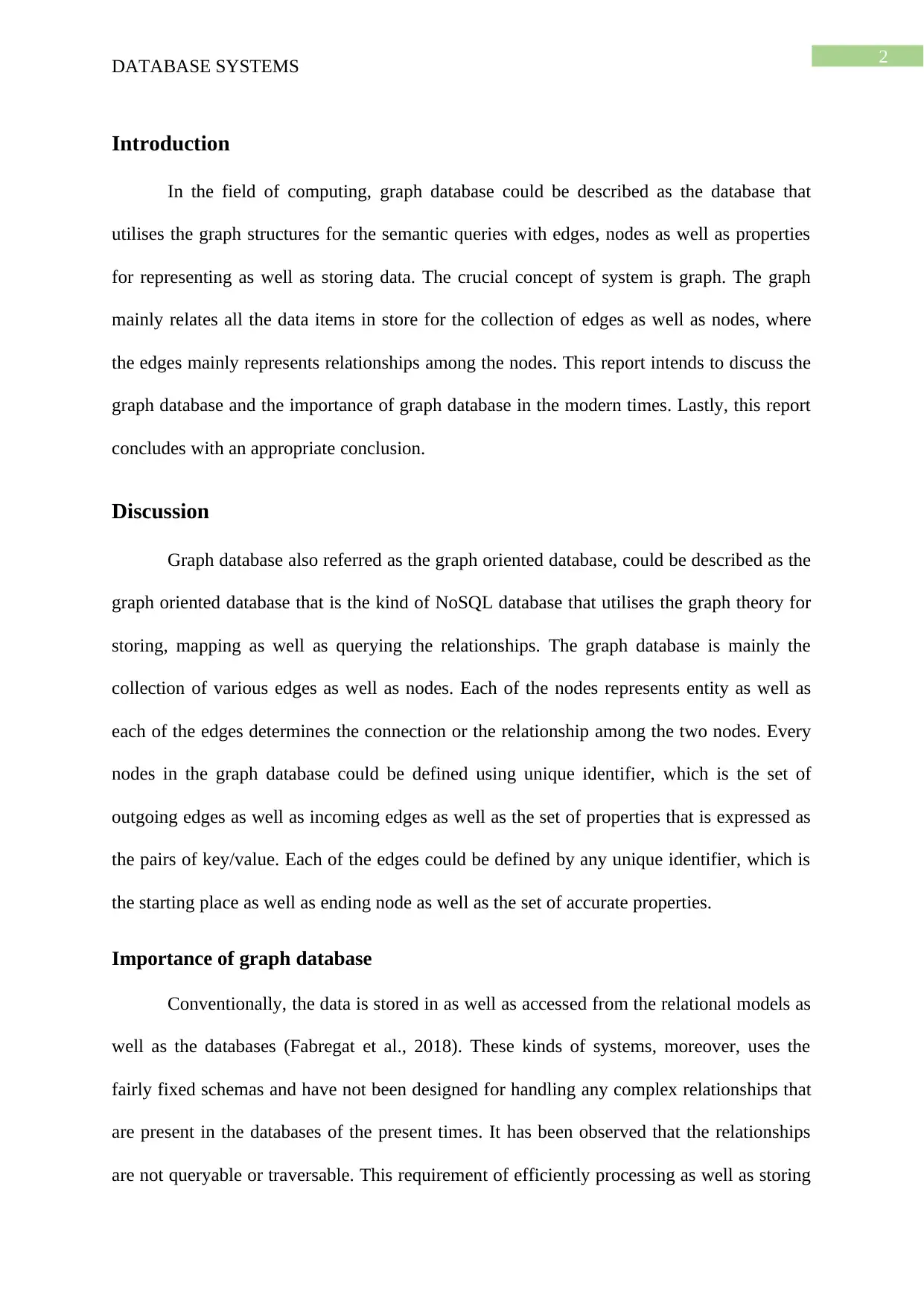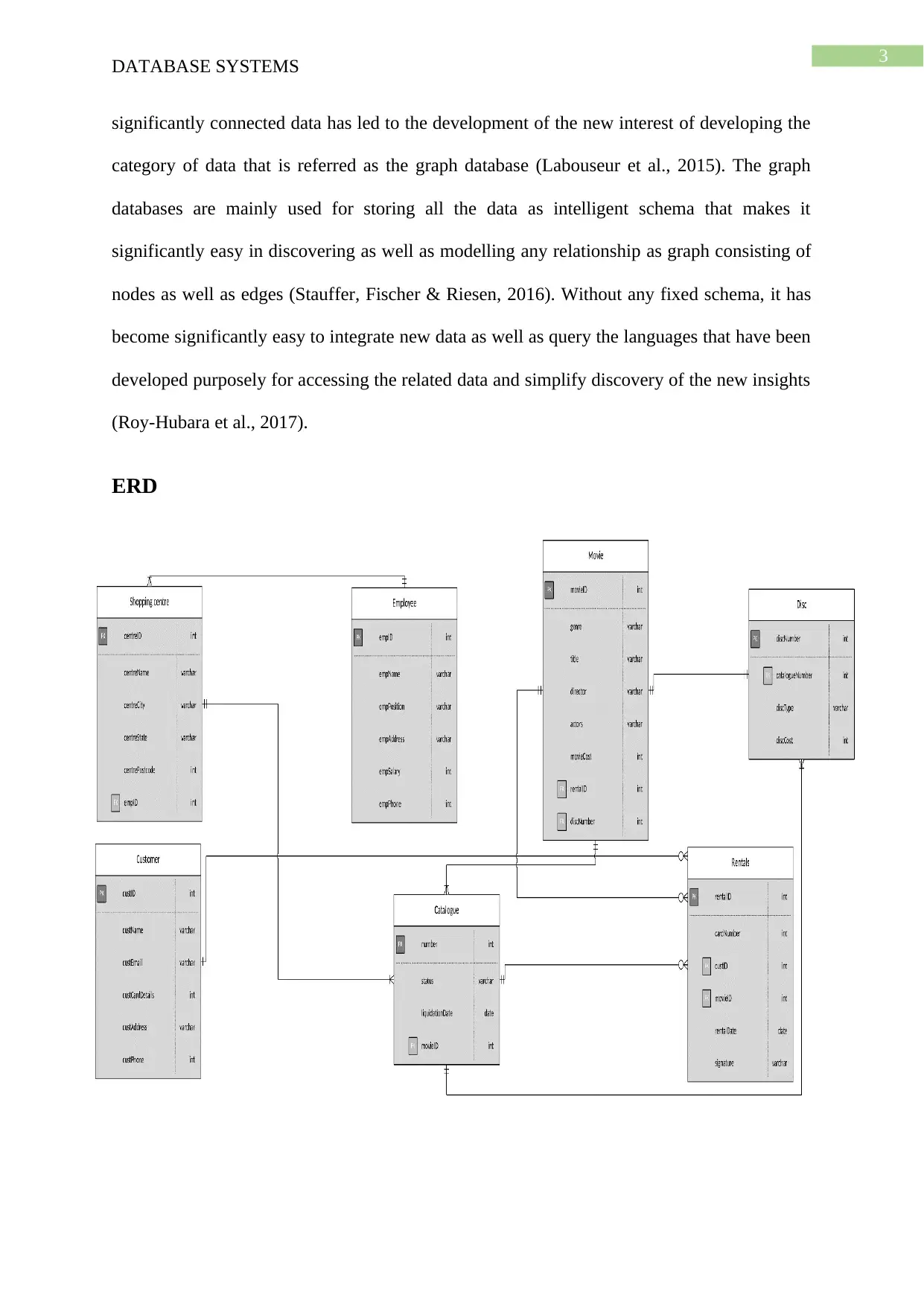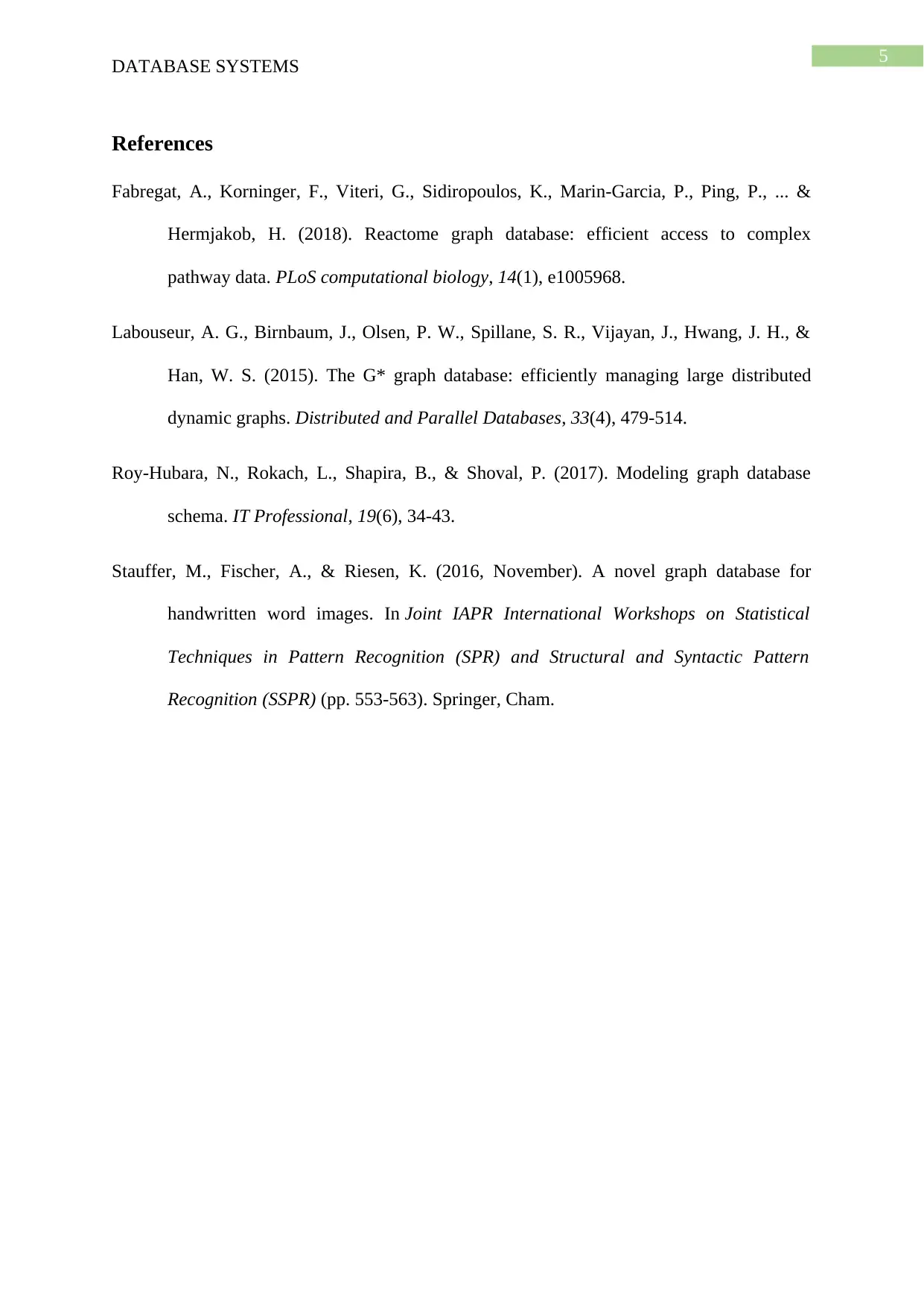Database Systems Report: Importance of Graph Databases
VerifiedAdded on 2022/09/01
|6
|802
|19
Report
AI Summary
This report provides an overview of graph databases, highlighting their structure and significance in contemporary data management. It defines graph databases as systems utilizing graph structures for semantic queries, emphasizing the roles of nodes, edges, and properties. The report discusses the importance of graph databases, contrasting them with traditional relational models and emphasizing their ability to handle complex relationships efficiently. It explains how graph databases store data using intelligent schemas, making it easier to model relationships and discover insights. The report concludes with a summary of the key concepts and the advantages of graph databases in modern data systems. The report also mentions the use of ERDs.

Running head: DATABASE SYSTEMS
DATABASE SYSTEMS
Name of student
Name of university
Author’s note:
DATABASE SYSTEMS
Name of student
Name of university
Author’s note:
Paraphrase This Document
Need a fresh take? Get an instant paraphrase of this document with our AI Paraphraser

1
DATABASE SYSTEMS
Table of Contents
Introduction....................................................................................................................2
Discussion......................................................................................................................2
Importance of graph database....................................................................................2
ERD................................................................................................................................3
Conclusion......................................................................................................................4
References......................................................................................................................5
DATABASE SYSTEMS
Table of Contents
Introduction....................................................................................................................2
Discussion......................................................................................................................2
Importance of graph database....................................................................................2
ERD................................................................................................................................3
Conclusion......................................................................................................................4
References......................................................................................................................5

2
DATABASE SYSTEMS
Introduction
In the field of computing, graph database could be described as the database that
utilises the graph structures for the semantic queries with edges, nodes as well as properties
for representing as well as storing data. The crucial concept of system is graph. The graph
mainly relates all the data items in store for the collection of edges as well as nodes, where
the edges mainly represents relationships among the nodes. This report intends to discuss the
graph database and the importance of graph database in the modern times. Lastly, this report
concludes with an appropriate conclusion.
Discussion
Graph database also referred as the graph oriented database, could be described as the
graph oriented database that is the kind of NoSQL database that utilises the graph theory for
storing, mapping as well as querying the relationships. The graph database is mainly the
collection of various edges as well as nodes. Each of the nodes represents entity as well as
each of the edges determines the connection or the relationship among the two nodes. Every
nodes in the graph database could be defined using unique identifier, which is the set of
outgoing edges as well as incoming edges as well as the set of properties that is expressed as
the pairs of key/value. Each of the edges could be defined by any unique identifier, which is
the starting place as well as ending node as well as the set of accurate properties.
Importance of graph database
Conventionally, the data is stored in as well as accessed from the relational models as
well as the databases (Fabregat et al., 2018). These kinds of systems, moreover, uses the
fairly fixed schemas and have not been designed for handling any complex relationships that
are present in the databases of the present times. It has been observed that the relationships
are not queryable or traversable. This requirement of efficiently processing as well as storing
DATABASE SYSTEMS
Introduction
In the field of computing, graph database could be described as the database that
utilises the graph structures for the semantic queries with edges, nodes as well as properties
for representing as well as storing data. The crucial concept of system is graph. The graph
mainly relates all the data items in store for the collection of edges as well as nodes, where
the edges mainly represents relationships among the nodes. This report intends to discuss the
graph database and the importance of graph database in the modern times. Lastly, this report
concludes with an appropriate conclusion.
Discussion
Graph database also referred as the graph oriented database, could be described as the
graph oriented database that is the kind of NoSQL database that utilises the graph theory for
storing, mapping as well as querying the relationships. The graph database is mainly the
collection of various edges as well as nodes. Each of the nodes represents entity as well as
each of the edges determines the connection or the relationship among the two nodes. Every
nodes in the graph database could be defined using unique identifier, which is the set of
outgoing edges as well as incoming edges as well as the set of properties that is expressed as
the pairs of key/value. Each of the edges could be defined by any unique identifier, which is
the starting place as well as ending node as well as the set of accurate properties.
Importance of graph database
Conventionally, the data is stored in as well as accessed from the relational models as
well as the databases (Fabregat et al., 2018). These kinds of systems, moreover, uses the
fairly fixed schemas and have not been designed for handling any complex relationships that
are present in the databases of the present times. It has been observed that the relationships
are not queryable or traversable. This requirement of efficiently processing as well as storing
⊘ This is a preview!⊘
Do you want full access?
Subscribe today to unlock all pages.

Trusted by 1+ million students worldwide

3
DATABASE SYSTEMS
significantly connected data has led to the development of the new interest of developing the
category of data that is referred as the graph database (Labouseur et al., 2015). The graph
databases are mainly used for storing all the data as intelligent schema that makes it
significantly easy in discovering as well as modelling any relationship as graph consisting of
nodes as well as edges (Stauffer, Fischer & Riesen, 2016). Without any fixed schema, it has
become significantly easy to integrate new data as well as query the languages that have been
developed purposely for accessing the related data and simplify discovery of the new insights
(Roy-Hubara et al., 2017).
ERD
DATABASE SYSTEMS
significantly connected data has led to the development of the new interest of developing the
category of data that is referred as the graph database (Labouseur et al., 2015). The graph
databases are mainly used for storing all the data as intelligent schema that makes it
significantly easy in discovering as well as modelling any relationship as graph consisting of
nodes as well as edges (Stauffer, Fischer & Riesen, 2016). Without any fixed schema, it has
become significantly easy to integrate new data as well as query the languages that have been
developed purposely for accessing the related data and simplify discovery of the new insights
(Roy-Hubara et al., 2017).
ERD
Paraphrase This Document
Need a fresh take? Get an instant paraphrase of this document with our AI Paraphraser

4
DATABASE SYSTEMS
Conclusion
Therefore, from the above discussion, it could concluded that the graph database
provides significantly advanced methods of storing data in databases. The graph database is
mainly the collection of various edges as well as nodes. The graph databases are mainly used
for storing all the data as intelligent schema that makes it significantly easy in discovering as
well as modelling any relationship as graph consisting of nodes as well as edges.
DATABASE SYSTEMS
Conclusion
Therefore, from the above discussion, it could concluded that the graph database
provides significantly advanced methods of storing data in databases. The graph database is
mainly the collection of various edges as well as nodes. The graph databases are mainly used
for storing all the data as intelligent schema that makes it significantly easy in discovering as
well as modelling any relationship as graph consisting of nodes as well as edges.

5
DATABASE SYSTEMS
References
Fabregat, A., Korninger, F., Viteri, G., Sidiropoulos, K., Marin-Garcia, P., Ping, P., ... &
Hermjakob, H. (2018). Reactome graph database: efficient access to complex
pathway data. PLoS computational biology, 14(1), e1005968.
Labouseur, A. G., Birnbaum, J., Olsen, P. W., Spillane, S. R., Vijayan, J., Hwang, J. H., &
Han, W. S. (2015). The G* graph database: efficiently managing large distributed
dynamic graphs. Distributed and Parallel Databases, 33(4), 479-514.
Roy-Hubara, N., Rokach, L., Shapira, B., & Shoval, P. (2017). Modeling graph database
schema. IT Professional, 19(6), 34-43.
Stauffer, M., Fischer, A., & Riesen, K. (2016, November). A novel graph database for
handwritten word images. In Joint IAPR International Workshops on Statistical
Techniques in Pattern Recognition (SPR) and Structural and Syntactic Pattern
Recognition (SSPR) (pp. 553-563). Springer, Cham.
DATABASE SYSTEMS
References
Fabregat, A., Korninger, F., Viteri, G., Sidiropoulos, K., Marin-Garcia, P., Ping, P., ... &
Hermjakob, H. (2018). Reactome graph database: efficient access to complex
pathway data. PLoS computational biology, 14(1), e1005968.
Labouseur, A. G., Birnbaum, J., Olsen, P. W., Spillane, S. R., Vijayan, J., Hwang, J. H., &
Han, W. S. (2015). The G* graph database: efficiently managing large distributed
dynamic graphs. Distributed and Parallel Databases, 33(4), 479-514.
Roy-Hubara, N., Rokach, L., Shapira, B., & Shoval, P. (2017). Modeling graph database
schema. IT Professional, 19(6), 34-43.
Stauffer, M., Fischer, A., & Riesen, K. (2016, November). A novel graph database for
handwritten word images. In Joint IAPR International Workshops on Statistical
Techniques in Pattern Recognition (SPR) and Structural and Syntactic Pattern
Recognition (SSPR) (pp. 553-563). Springer, Cham.
⊘ This is a preview!⊘
Do you want full access?
Subscribe today to unlock all pages.

Trusted by 1+ million students worldwide
1 out of 6
Related Documents
Your All-in-One AI-Powered Toolkit for Academic Success.
+13062052269
info@desklib.com
Available 24*7 on WhatsApp / Email
![[object Object]](/_next/static/media/star-bottom.7253800d.svg)
Unlock your academic potential
Copyright © 2020–2025 A2Z Services. All Rights Reserved. Developed and managed by ZUCOL.





